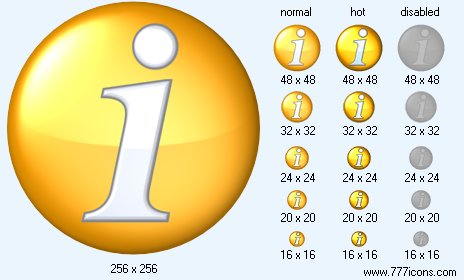


|
| ||||||||
|
|
Info Icon |
|
Image sizes: 256x256, 48x48, 32x32, 24x24, 20x20, 16x16
File formats: BMP, GIF, PNG, ICO
Using The Correct Image Format For Your Icons.
There are innumerable image file formats that should be put to use for saving images and for an inexperienced designer this can often turn into a major issue because you will need to know how to incorporate a particular file format, offered in this article is a take on the advantages and issues of some popular formats.If you are keen on icon making or would like to create icons for your web page, it is essential to find out more about the various image formats and their traits so that you can utilize the correct file format for graphics. Normally used file formats for pictures are GIF, JPEG and PNG, each one of these file formats is known to have its own merits so lets look at the benefits and drawbacks of using these file formats, the type of image that should meet the expectations your website and optimizing your icons for the web usage.
GIF: It is the abbreviation for Graphics Interchange Format; the format is one of the more well known file types. The image format is well accepted because of its small size which makes uploading less time consuming. But like in the JPEG format, data is not lost in this image format which means you could store the file in a smaller size without compromising the quality of the images. Since GIF supports transparency in graphics, it is by far the most suitable image formats for picture designing. Unlike the other file types, animation is also offered in GIF. If you would like to optimize a GIF file, it is necessary to keep the size of the image small; it would be best that you choose a 32 color palette to achieve a suitably small size.
JPEG: This is short for Joint Photographic Experts Group; the image format is commonly called JPG and is often incorporated for online graphics. One of the principle advantages of utilizing this type of file is that you could store the images in true color that affords you an impressive range of 16 million colors; making this image type ideal for saving photos and graphics that include intricate color range. One of the cons of utilizing JPG is the data loss that is encountered every time the file is saved; this points to the fact that the image is marred by clarity issues and some information may be lost. Unlike other file formats such as GIF, transparency is not possible in this file type. If you are utilizing an innovative image editing program such as the Adobe Photoshop, you can select the image quality and the image file size ; however, it is vital to realize that a lower resolution equates to a smaller size, which is simple to upload.
PNG: Is an abbreviation for Portable Network Graphics and is a relatively fresh file format. PNG format is available in two forms; PNG-8 which offers 8 bit color format and the PNG-24 which uses 24 color graphics. PNG-8 can curtail the size graphics with great detail and without the customary loss of details experienced in GIF files; this leads to improved picture quality and quick upload time. But, PNG-24 is not as effective as JPG when you want to store photographs and other illustrations that merit the use of a more detailed color palette. The file type is loss-less; this means that the image retains its clarity and quality. PNG-24 offers the transparency feature and you can utilize various levels of of the feature in this format. When you use this file format the images are professional looking because you cant see jagged lines when placed in relation to a background with contrasting colors like GIF files.
Copyright © 2006-2022 Aha-Soft. All rights reserved.
|

